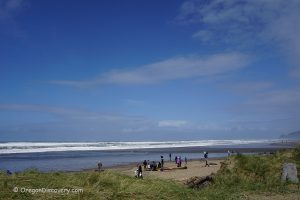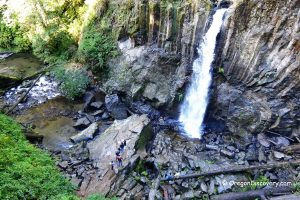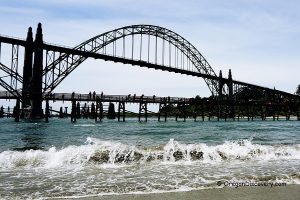The local Lincoln City history from the earliest peoples to the modern days is an important chapter of Oregon history.
The archeological evidence indicates that the area was inhabited for thousands of years before the first Europeans appeared in the 19th century. The Coastal Salishan tribes, including Siletz, Tillamook, and Nehalem people fished, hunted, and gathered roots, nuts, and berries in blissful isolation until the time when the Europeans started coming and settling.
Portugal, Spain, and England among other countries showed their interest in the exploitation of the natural resources of America. In 1579, Sir Francis Drake made his exploration of the area and named it New Albion.
In 1788, Captain Robert Gray participated in the maritime fur trade with coastal Native tribes. His ship "Lady Washington" was the first American vessel that made landfall on the Central Oregon Coast. The third officer of the ship, Robert Haswell, described in his journal that two or three Indians had been scarred by smallpox. The highly contagious disease may have been introduced by Europeans earlier.
In 1837, the first recorded four tourists who came by horses made their way along the trails of the Salmon River. These tourists camped around the Oceanlake area. Two just-married couples, Anna Marie Pittman and Jason Lee, along with Susan Downing and Cyrus Shepard spent their honeymoons traveling from the Willamette Valley through the dense forest of the Coast Range to the Pacific Ocean.
In 1849, Lieutenant Theodore Talbot explored the area coming via the Salmon River trail on horseback. With this preview of exploration, it is a clear indication that most of the occupants of the current Lincoln City came as tourists and explorers. The area remained untouched by modern development due to its inaccessibility until the 1890s.
In 1855, just after a series of conflicts between settlers and Native Americans in Southern Oregon, President Franklin Pierce signed an executive order establishing the Siletz Reservation to relocate Native Americans from Southern Oregon and Northern California. Later, the reservation area was decreased by the "Act of Congress, 1875" and "General Allotment Policy, 1887" known as the Dawes Act. The Dawes Act authorized the President of the United States to impose land ownership on Native Americans.
When lands of the Siletz Reservation became available, early European settlements were established. The first settlers were fishermen who were attracted by great opportunities to catch a large number of salmon in the Siletz and Salmon Rivers. Farmers and homesteaders came to the region in the late 1890s.
The biggest obstacle that new settlers faced was the absence of any roads or ship services to get there. Wagon Road from the Willamette Valley ran through the dense forest and steep rocky inclines of the Coast Range. The trail was inaccessible during the winter months. The trip from Salem took five or six days. Homesteaders usually came by water, arriving in Portland by a steamboat. They hired or bought a horse or wagon to get to their new homes. Connections between the coastal towns were possible along the beaches during low tide.
The construction of Roosevelt Military Highway (Highway 101) in the 1920s and Salmon River Highway (Highway 18) in 1932 made a dramatic impact, encouraging economic development and tourism, as well as establishing new communities along the coast.
Incorporated in March 1965 following the merging of the five region's districts, the city was named after the former president of the United States, Abraham Lincoln.
Historic Districts or "String of Pearls"
Wecoma Beach
Wecoma Beach is located on the north of Lincoln City. The Indian word Wecoma means "sea". Wecoma has been the spot where people, traveling along the Salmon River, got a first impression of the ocean. Now, the word "Wecoma" carries another meaning: "Welcome to the Waters!"
Oceanlake
Oceanlake is sited on the north bank of the world's shortest D River and south of the Salmon River. Herbert Rexroad became one of the first inhabitants of Oceanlake in the early 1930s. He established a campground that grew into a great picnic spot.
With the emergence of different enterprises, the other investors came and established their businesses. In 1926, before the town was named, A. C. Deuel established a post office and became the first postmaster.
 DeLake
DeLake
DeLake is located between Devils Lake and the ocean, in the geographical center of Lincoln City.
Mr. and Mrs. Henry Hostetler, as well as brothers Alvin and Harry Thorpe, were the first DeLake residents. Hostetler's family purchased Native American allotment land in 1910. The origin of the town's name has a few versions. One of them: early Finnish settlers would say, “I’m going to de lake”. In another explanation, the d and e constitute a French word meaning “by”—hence, the area “by the lake.”
Nelscott
Nelscott is located on the south bank of the D River.
Nelscott was named by combining the last names of Charles P. Nelson and Dr. W.G. Scott, who purchased this land. They founded the community in 1926 and formed the Nelscott Land Company.
Taft
Taft is situated on the north shore of Siletz Bay. In 1895, Sissy and Jakie Johnson became the first residents of the area. They received their land under the General Allotment Act. Johnson farmed and ran a rowboat ferry service on Siletz Bay. Taft became a hub for many festivities for both social and economic life.
Different entrepreneurs established their businesses. Among the key entrepreneurs was John W. Bones who built the first store. He also became the first person to come up with the post office in January 1906. The town grew rapidly hence attracting other enterprises.
Cutler City
Cutler City is located on the east shore of Siletz Bay. The district was originally part of an allotment of Siletz Indian Charlie Depoe. Mary and George E. Cutler bought the land and established a town in 1913. In 1930, a post office was open and the town officially became Cutler City.
Oceanlake, DeLake, Nelscott, Taft, and Cutler engaged in competition in terms of business and tourism. All districts grew independently from each other with their enterprises, hospitals, and churches. However, local residents understood that consolidation of all small communities into one city is necessary to upgrade the water and sewer systems, improve fire and police protection. In 1964, the towns voted for the consolidation and won by three votes. In 1965, the new city named Lincoln City was incorporated and was headed by a mayor who was also elected.





